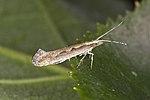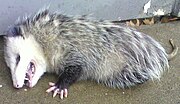Chrysoperla is a genus of common green lacewings in the neuropteran family Chrysopidae. Therein they belong to the Chrysopini, the largest tribe of subfamily...
15 KB (1,240 words) - 21:29, 21 May 2024
Chrysoperla carnea, one of the species of common green lacewing, is an insect in the Chrysopidae family. Although the adults feed on nectar, pollen and...
14 KB (1,451 words) - 03:51, 1 August 2024
Chrysoperla rufilabris, also known as the red-lipped green lacewing, is a species of green lacewing in the family Chrysopidae. This species is native...
4 KB (259 words) - 20:58, 13 February 2024
Chrysoperla plorabunda, also known as the weeping green lacewing, is an insect belonging to the cryptic carnea complex of the genus. Species in the complex...
16 KB (1,945 words) - 09:54, 8 September 2024
species in this widespread group. Members of the genera Chrysopa and Chrysoperla are very common in North America and Europe; they are very similar and...
16 KB (1,632 words) - 08:19, 13 October 2024
Chrysoperla lucasina is a species of neuropteran of the family Chrysopidae (subfamily Chrysopinae). They are found mainly in the United Kingdom, the Czech...
3 KB (321 words) - 04:27, 28 February 2024
neuropteran family Chrysopidae. Members of this genus and the genus Chrysoperla are common in much of North America, Europe and Asia. They share similar...
4 KB (294 words) - 12:09, 5 April 2024
parasitoids Trichogramma chilonis and Cotesia plutella and the predator Chrysoperla carnea, a lacewing. Lacewings feed on eggs and young larvae, while the...
36 KB (4,452 words) - 01:50, 4 October 2024
an important intraguild predator on arthropods, such as the lacewing Chrysoperla carnea, which is commonly used to control cotton aphids (Aphis gossypii)...
22 KB (2,707 words) - 14:46, 24 August 2024
primarily use temperature to determine when to enter diapause. Similarly, Chrysoperla plorabunda lacewings regulate their reproductive cycle using daylight...
24 KB (2,776 words) - 06:10, 2 November 2024
Prepupa (left) and pupa (middle & right) of Chrysoperla carnea (Neuroptera)...
10 KB (1,143 words) - 14:52, 15 September 2024
within the family and comprises about 60 genera. Members of the genus Chrysoperla and the genus Chrysopa in this subfamily are common in Europe and North...
9 KB (718 words) - 07:35, 13 August 2023
habitat for birds and beneficial rodents. For example, insects such as Chrysoperla carnea and the Ichneumon fly can prey on pests. The concept was developed...
3 KB (319 words) - 15:58, 30 December 2023
control of B. tabaci: Delphastus pusillus, Macrolophus caliginosus, Chrysoperla carnea, and C. rufilabris. D. pusillus is a species of small, shiny,...
31 KB (3,637 words) - 04:34, 17 July 2024
synthesis inhibitor buprofezin on survival and development of immatures of Chrysoperla rufilabris (Neuroptera: Chrysopidae). J Econ Entomol. 2000 Apr;93(2):234-9...
2 KB (159 words) - 08:37, 7 September 2024
more likely to copulate with females and copulated longer. Larvae of Chrysoperla plorabunda engage in tonic immobility when they come into close proximity...
49 KB (5,658 words) - 17:10, 1 November 2024
: 365–373 Invertebrates of note include the cheese-weed moth lacewing (Chrysoperla species). The Hermes copper and Quino checkerspot butterflies among the...
18 KB (1,621 words) - 02:54, 26 October 2024
toxin (Cry1Ab) has no direct effect on larvae of the green lacewing Chrysoperla carnea (Stephens) (Neuroptera: Chrysopidae)". Journal of Insect Physiology...
7 KB (492 words) - 23:31, 6 January 2024
Daniel E. (1990-10-01). "Effects of Pesticides on Pecan Aphid Predators Chrysoperla rufilabris (Neuroptera: Chrysopidae), Hippodamia convergens, Cycloneda...
22 KB (2,769 words) - 23:37, 14 August 2024
This neuron has a single dendrite and several cilia extend from it. In Chrysoperla carnea, the green lacewing, the organ is involved in sexual behaviour...
16 KB (2,062 words) - 00:56, 3 July 2024
convergent ladybird H. convergens. Larvae of the common green lacewing Chrysoperla carnea consume both eggs and larvae. The spined soldier bug Podius maculiventris...
9 KB (892 words) - 20:48, 5 September 2024
predators such as Pholcus phalangioides, Stagmomantis californica, and Chrysoperla carnea were unaffected. Thus it was concluded the high nickel concentration...
4 KB (377 words) - 02:00, 30 September 2024
Chloroplaga pallida, a species of moth in the subfamily Chloephorinae Chrysoperla pallida, a species of lacewing Chusquea pallida, a species of bamboo...
5 KB (615 words) - 23:23, 6 January 2021
mushroom Canna carnea, a garden plant Chromodoris carnea, a sea slug Chrysoperla carnea, a common lacewing Columbella carnea, a sea snail Conferva carnea...
481 bytes (85 words) - 11:59, 24 February 2013
web-building behaviors prior to the emergence of the larva parasite. Chrysoperla carnea and Coccinella septempunctata are natural enemies of P. cespitum...
19 KB (2,367 words) - 13:44, 21 July 2024
(2009). "Occurrence of insecticide resistance in field populations of Chrysoperla zastrowi arabica (Neuroptera: Chrysopidae) in India". Commun. Agric....
19 KB (2,127 words) - 02:56, 9 August 2024
Pseudaspidimerus trinotatus (Thunberg) (Coleoptera : Coccinellidae) and Chrysoperla carnea (Stephens) (Neuroptera : Chrysopidae) on bean aphid, Aphis craccivora...
4 KB (307 words) - 19:08, 23 August 2023
predatory bugs Anthocoris nemoralis and Deraeocoris spp., the green lacewing Chrysoperla carnea and several ladybirds. The wasp Trechnites psyllae was the main...
6 KB (693 words) - 04:13, 17 July 2024
Heteroptera and Neuroptera groups. Specific examples include Orius spp, and Chrysoperla carnea which were observed feeding on nymphs. Other nymphs were also...
21 KB (2,352 words) - 05:55, 23 September 2024
ladybird beetles, Aphidoletes aphidimyza, or other syrphid fly larvae and Chrysoperla species, the green or brown lacewings. Several species of Aphelinus,...
30 KB (3,274 words) - 04:25, 12 August 2024
























